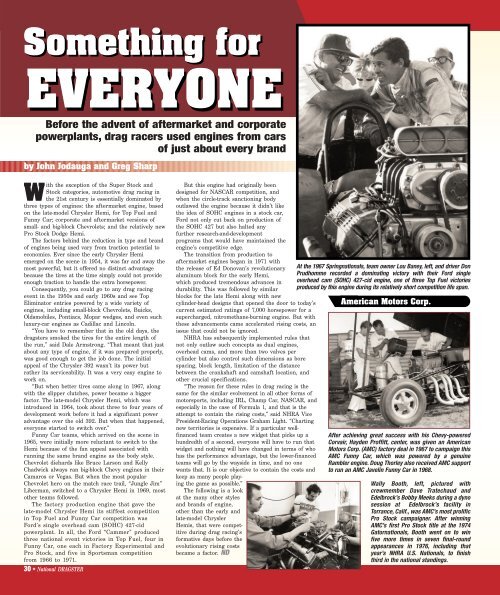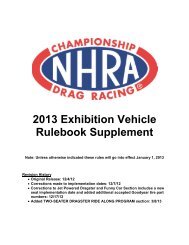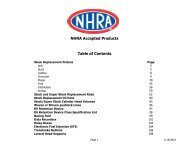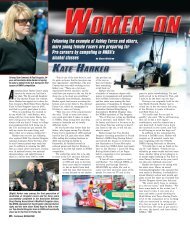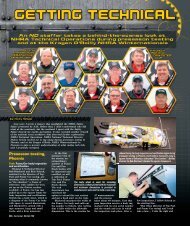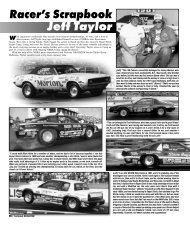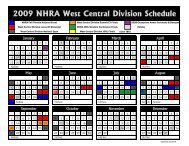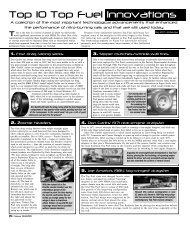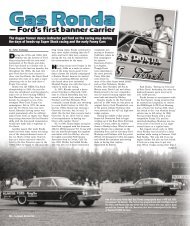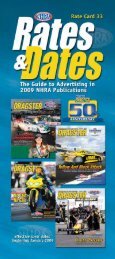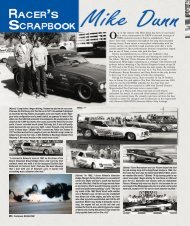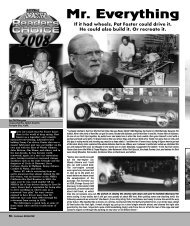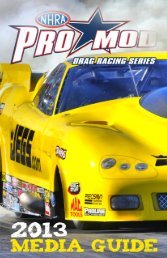Something for Something for - NHRA.com
Something for Something for - NHRA.com
Something for Something for - NHRA.com
- No tags were found...
Create successful ePaper yourself
Turn your PDF publications into a flip-book with our unique Google optimized e-Paper software.
BuickBuicks were never popular in Top Fuel,but racers such as "T.V. Tommy" Ivothrived with Buick powerplants in theTop Eliminator days of the fuel-ban era.The first hot rod that Ivo purchased camewith a Buick engine, and he immediatelydeveloped a liking <strong>for</strong> the engine’sdistinct appearance with its verticalvalve covers. Said Ivo, "If you skatedgood enough to win a race, you werepretty good. But if you skated backwardand won, you were really very good."ChevroletCadillacCadillac engines have long been associatedwith luxury vehicles, but “Ohio George”Montgomery was able to extract enoughpower from his Cadillac-powered ’33 Willys(right) to win the first of his three <strong>NHRA</strong>Nationals titles, a Little Eliminator victory, in1959. Another successful Cadillac entry wasthe Yeakel Brothers Top Eliminator entryowned by Lou Baney and driven by KennyArnold. It was later sold to the Cook &Bedwell team, and its 166.97-mph run atLions Drag Strip in February 1957 promptedconcern over lack of stopping distance andimmediately led to the fuel ban of 1957-1963.The fabled small-block Chevy has won far more nationalevent titles than any other engine. Jack Chrisman, right,was the first driver ever to win a Top Eliminator crown withthe powerplant, driving his twin-engine Howard CamsSpecial to victory at the 1961 Winternationals. The onlyother Top Eliminator winner that was powered by a smallblockChevy was Pete Robinson, who drove hissingle-engine entry to victory at that year’s <strong>NHRA</strong> Nationals.Jim Bucher was the only driver to ever score a Top Fuelvictory with a Chevy-powered entry. He ran a 6.57 withhis Chevy big-block (above) to defeat Gary Beck in thefinal round of the 1975 <strong>NHRA</strong> Summernationals inEnglishtown.Bruce Larson’s famed series of USA-1 Chevrolet FunnyCars were powered by genuine big-block Chevrolets; heresisted the temptation to switch to the more powerfullate-model Chrysler Hemi. Other Chevy campaigners whofollowed suit were Kelly Chadwick and Dickie Harrell.DeSoto Hemi Dodge Hemi Dodge-PlymouthGene Adams and Don Enriquez began racing in the late1960s with a Jr. Fuel entry that was powered by a 305-cidDeSoto engine. Their entry was the first unblown car toclock a backed-up run in excess of 200 mph at an <strong>NHRA</strong>track (Orange County Int’l Raceway in 1969), and they wonComp at the 1970 Winternationals and Supernationals andthe 1971 Springnationals while running the car in A/FD.FordThe granddaddy of all hot rodding engines, the famed Ford flatheadthat was originally introduced in 1932, faced stiff<strong>com</strong>petition from the new breed of overhead-valve engines thatwere developed in the early 1950s. But that didn’t stop JohnBradley (right) from campaigning the venerable powerplantwith surprising success until the end of the decade. His Gene’sBrake Shop Special was runner-up at the 1958 World Series ofDrag Racing in Cordova, Ill., and he earned more than 50 TopEliminator titles and numerous track records in 1957 and 1958.Calvin Rice was another prominent flathead campaigner; hewon the inaugural <strong>NHRA</strong> Nationals in 1955.As did DeSoto, Dodge manufactured its own version ofthe early Chrysler Hemi. Bill and Jack Stecker ran this241-cid powerplant in Top Eliminator. Jack Ewell wasone of the car’s drivers.Chrysler Corp.began backingmany drag racersin the early1960s, and oneof its earliestsuccesses wasJim Nelson,wearing lei, andDode Martin’sTop Eliminatorvictory at the 1962 Winternationals with their Dodgewedge-powered Dragmaster Dart. Tony Nancy followed bydriving his Plymouth wedge-equipped entry to a Comp victoryat the 1963 Winternationals.While Ford’s 312-cid “Y-block” engine (left)could not match the high-revvinghorsepower of the small-block Chevy,it still enjoyed various degrees ofsuccess. Ace engine builder and tunerLes Ritchey, <strong>for</strong> instance, scored 33class wins and held class records at fivedifferent dragstrips with his ’56 Victoria.Other prominent Y-block racers were Karol Miller, who workedwith Rodney Singer; Doane Spencer of Bonneville and roadracing fame; and Vern Houle, who worked with Bill Stroppe.to page 32May 5, 2006 ✦ 31
from page 31FordThough the 426 Hemis and 427 SOHC Fords were thedominant powerplants during the early days of Funny Car<strong>com</strong>petition in the mid-1960s, Doug Nash became acrowd favorite with his lightweight Bronco Buster, whichwas <strong>com</strong>petitive even with the vehicle’s diminutive289-cid small-block Ford engine. Earlier in the decade,Robinson campaigned a <strong>com</strong>petitive Top Gas entry with a289-cid small-block Ford.Connie Kalitta was the first driver to campaign Ford’ssingle overhead cam Hemi in Top Fuel <strong>com</strong>petition. Hedebuted the entry at the 1965 Winternationals, and hewent on to win the 1967 Winternationals. Other FordSOHC Top Fuel winners were Robinson (1966 WorldFinals) and Prudhomme (1967 Springnationals) withBaney’s Brand Motors Ford entry.LincolnRodney Singer,pictured in the car,wheeled his Hot RodLincoln to a TopEliminator victory atthe 1959 Nationals.Other Lincolncampaigners whoearned TopEliminator titles atlocal events wereTed Cyr and LelandKolb.PackardWhen weight breaks were introduced to Pro Stock<strong>com</strong>petition in 1972, the larger 427 SOHC and Boss 429powerplants were quickly replaced by various versionsof Ford’s 351-cid small-block engine. The teams of DonNicholson and Gapp & Roush enjoyed great success withthis <strong>com</strong>bination, but the man who produced the mostvictories with the Ford 351 was Bob Glidden, left, whoscored 34 national event triumphs from 1973 to 1981.The Ford “Cammer” ruled the Funny Car ranks in 1966and 1967, when Eddie Schartman, near lane, and “DynoDon” Nicholson had the category covered by two- tothree-tenths of a second with their Logghe Bros.-builtMercury Comets.OldsmobileMickey Thompson’s Harvey Aluminum entry, which waspowered by a 427-cid wedge, was a rare Ford big-blockin Top Eliminator. Thompson, inside the car and picturedwith <strong>NHRA</strong> founder Wally Parks, later created his ownHemi cylinder heads <strong>for</strong> this <strong>com</strong>bination. Gas Rondadrove a 427-cid wedge-powered Ford Thunderbolt to the1964 <strong>NHRA</strong> Stock national championship.PontiacWhile many Ford ProStock racers struggledwith the “Boss 429,”Bob Glidden used thehuge engine todominate the categoryafter <strong>NHRA</strong> switched tothe 500-cid <strong>for</strong>mat in1982. Glidden won 54races and five <strong>NHRA</strong>Pro Stock nationalchampionships withthis engine.Eddie Hill really caught everybody’s attention when heshowed up at the <strong>NHRA</strong> Nationals in the early 1960s withthis twin-engine Pontiac that sported four racing slicks atthe rear. The added traction was so great that the car toreup part of Indianapolis Raceway Park’s starting line duringits launches. The most prolific Pontiac-powered car in TopFuel <strong>com</strong>petition was the famed Ernie’s Camera entry.Even lesser-knownbrands, like Packard, werea presence at dragstripsduring the 1960s. DonDuncan, who worked <strong>for</strong>Louie Senter’s AnsenAutomotive, ran thissupercharged Packard inTop Fuel.32 ✦ National DRAGSTERWhen the fuel ban was lifted in1964, a small number ofOldsmobile-powered entries, suchas the Saf<strong>for</strong>d, Gaite & Ratican car(pictured) and the Porter & Reismachine, earned more than theirfair share of Top Fuel titles. Earlierin the decade, Leonard Harrisdrove the famed Albertson Oldsentry to Top Eliminator honors atthe 1960 Nationals.Arnie “the Farmer” Beswick was probably the most popularcampaigner of a genuine Pontiac-powered Funny Car on thematch-race circuit during the 1960s. He was so successfulwith his Pontiac that he was given a factory deal tocampaign a Mercury Comet in 1965. But fans on the matchracetrail opposed the switch so much that he abandonedthe sponsorship support to resume running his Pontiacs asan independent campaigner.


